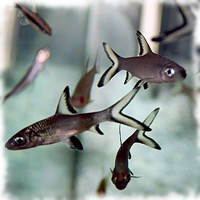The shark baloo, also called the shark barb or "shark bala", is a small freshwater fish of the carp family. Don’t let the frightening name of this breed fool you: the fish are called that only because of their external similarities in body structure with the bloodthirsty killers of the same name.
The fish has nothing to do with predators; rather, on the contrary, it is calm, peaceful and friendly. Despite its formidable appearance, the shark baloo does not show any aggression towards its “neighbors,” even if they are smaller in size. Thus, the compatibility of these small funny creatures is possible with almost any pet that will not show belligerence towards them.
In nature, this species lives in Thailand and on the southeastern island of Kalimantan. Their natural habitat is streams and rivers with fast, intense currents. The natural deposit made the fish fast, agile and resilient.
The distinctive external features of the fish are the body narrowed on the sides and a sharp protruding vertebral fin. The Shark Baloo has large, protruding eyes with distinct pupil contrast. The fish is also notable for its lack of antennae.
In terms of compatibility, the shark baloo is superior to many ornamental fish, and can be kept with all kinds of breeds, except for very small ones. The latter are excluded only because your fish may mistake them for food. Keeping a pet is not too troublesome: aquarium balus are strong and unpretentious to food.
Aquarium for your pet
Because of this, the pet’s “apartment” has to be significantly expanded, which is beyond the means of many average people. If you have the opportunity to purchase an aquarium with a volume of 300-400 liters, this fish will be your best choice.
Shark baloo is an active fish, but at the same time shy. Therefore, she needs enough space to move and hide. Representatives of the breed love large aquariums with an abundance of living vegetation. Please note that this fish belongs to the schooling category, so loneliness can be disastrous for it. Compatibility of shark baloo fish is possible with almost any breed.
We are setting up a new castle for future inhabitants. Main nuances:
- When choosing a container, choose an aquarium with a volume of 400+ liters. For juveniles, 300 liters is enough, but is there any point in changing housing as they grow older?;
- Your aquarium must be closed or optional. Fish may jump out of the water in your absence;
- The larger the “dwelling”, the healthier and larger the fish will grow. Living in a spacious artificial reservoir, individuals can reach 40 cm in length;
- Due to the shyness of your new pets, decorate the container in advance with dense vegetation, driftwood and soil;
- Plants in water should not be too vulnerable and delicate - fish can damage them;
- Decorate the aquarium with Anubias, Lintophylls, Vallisneria, Echinodorus, Crinum;
- Don't go overboard with the "design". Give the fish enough free space;
- Place several small driftwood in the middle of the aquarium.
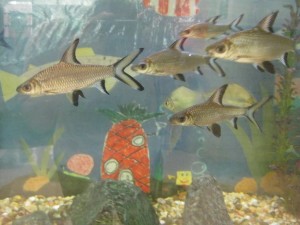
As you already know, this peaceful disposition is fantastic. beautiful fish complemented by excessive timidity. Shark baloo is a fish that is somewhat susceptible to stress. She does not tolerate frequent transportation - this is another reason to take care of a spacious home until your pets grow up.
Adaptation to a new habitat is also complicated for this breed. Representatives are prone to emotional shocks, and particularly impressionable individuals may even die from an overabundance of impressions. We recommend that all manipulations to sanitize the container be carried out with extreme caution, especially during the first days of the fish’s residence at your home.
Under no circumstances should you intentionally scare the fish: knock on the walls, shine a flashlight through the glass, or make sudden movements with your fingers:
Interesting fact: the breed is listed in the Red Book as an endangered species. The reason for this is the breed’s hypersensitivity to pollution. You probably guess that maintaining your shark ball will require you to carefully monitor the cleanliness of the liquid environment.
Despite some nuances that may cause you minor inconvenience, you can rightfully be proud of your purchase, because you will become the owner of an exceptionally rare breed of fish!
Water parameters and other technical nuances
When the comfort of your future pets has already been ensured, it’s time to think about technical issues directly related to the health and growth of fish. Aquarium fish of the Shark Baloo breed do not require any special characteristics from their habitat.
However, the standard options will still have to be taken into account:
- The optimal water temperature for keeping fish is 23-26°C;
- If your home is cool, purchase a special thermostat-heater in advance;
- Your new pets are not afraid of steep currents, so you can use a regular filter instead of a sponge filter. The main thing is that the filtration system meets basic quality standards;
- For excellent health of fish, a weekly change of 40-50% of water is recommended;
- Maintain the acid-base balance of the environment within pH 6.5-7;
- dH (water hardness) should not exceed the permissible threshold of 14-16°;
- Aeration is necessary regardless of planting density.
Feeding the fish
Shark fish are absolutely unpretentious in terms of nutrition. They eat almost everything, but keep in mind that your new pets are quite voracious and greedy. There is no need to overfeed them.
Excessive culinary experiments are also not recommended: they can cause your fish to have digestive problems and get sick. You should not feed the Bala with cheeses. Be sure to include plant nutrition in your diet.
You can feed the newly acquired inhabitants of the aquarium with the following products:
- Dry and granulated industrial feeds;
- Live (in particular, frozen) food;
- Bloodworm (in limited quantities);
- Worms;
- Shrimp and mussel meat;
- Artemia.
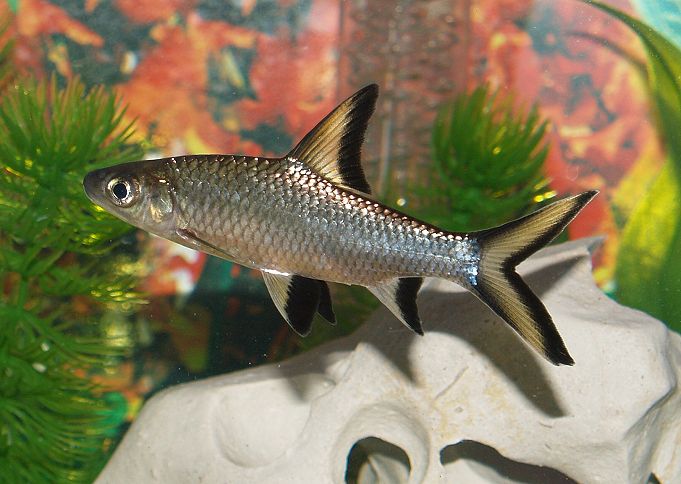
When eating, individuals can make funny gurgling sounds due to the characteristic gripping of the gills. We recommend that you feed the fish several times a day, calculating portions so that your pets can finish them in 1.5-2 minutes.
If you use dry food, alternate between them periodically. Plant foods must be included in the menu, even if you use high-quality feed and live protein foods!
Shark baloo is an amazing breed of fish with a whole range of undeniable advantages. True collectors and connoisseurs dream about the content of this type. Try to match the valuable characteristics of your future pets, and become a truly worthy, caring owner for them!
Features of the Shark Ball
Shark Ball has several names, for example, shark barb or shark bala. However, the biggest misconception that the names introduce is the word “shark” present in each of them.
The fish has nothing in common with a shark, except for the shape of the body and the high dorsal fin, precisely because shark ball only on photo could be mistaken for a real giant shark. IN wildlife shark ball size can reach only 40 centimeters.
This species has a rather gentle character, not prone to aggression, and gets along well with other representatives of the family. water world(fish, snails, etc.). The shark barb is a very strong fish, not picky about food.
Despite the fact that in the wild the shark barb grows up to 40 centimeters, when living in captivity its body length hardly reaches 30.
Baloo shark fish has an oblong body, and, relative to the body, very large eyes, which became so in the process of evolution due to the constant search for food.
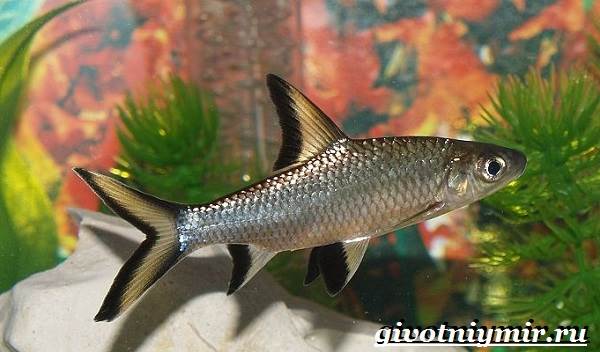
Baloo sharks are usually silver in color. Slightly darker on top, on the back, and lighter below, on the belly.
It boasts large, beautiful fins that have a yellow or white stripe in the middle and a black edge.
This species at any age prefers the company of its own kind; for the health of the pet it is imperative to keep at least five individuals.
Like other schooling fish, the shark's life system has a strict hierarchy. Despite the fact that the fish has a soft and non-aggressive character, the strict hierarchy forces the dominant representatives of the shark ball to behave unfriendly towards the less dominant ones.
However, if shark ball will in the aquarium presented in a single copy, he will become bored (or scared) and the rest of the fish will certainly suffer from this.
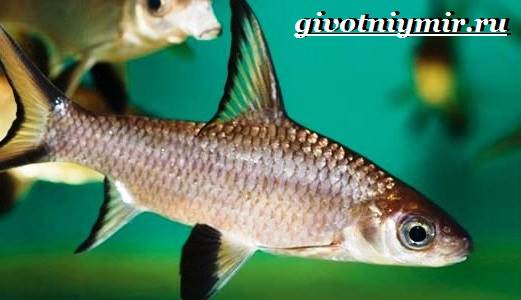
Shark baloo is a very active fish. In order to have good health, important condition for balu - a lot of swimming, that is, when getting such a fish, you need to immediately count on an aquarium, if not half, then definitely a third of the wall.
Also in the aquarium you should plant (or place artificial) plants and decorative elements, so that the bala can hide.
The first specific figure allowed for the life of a flock of barbs is 300 liters, which should subsequently increase by at least five times (with the growth of the fish).
Of course, the water must certainly be clean, since shark ball - now an aquarium inhabitant , First of all, river fish, which in nature lives in running water.
The quality of the decor is not particularly important for him; the availability of free space is much more important.
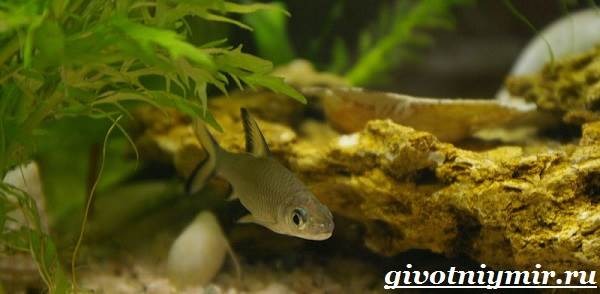
The most advantageous advantage shark ball content- the habit of looking for food at the bottom, thereby maintaining cleanliness on its own.
Compatibility of shark balu with other fish in the aquarium
Thanks to its peaceful nature, the shark ball gets along with any representatives of the aquatic world, the main thing is that the neighbors are approximately equal in size.
However, the baloo can eat smaller fish, despite the fact that it is not initially a predator.
That is, strict rules on shark ball compatibility With other species, the most important thing is to monitor the size of the wards.
Feeding and lifespan of the shark
Almost all standard fish food options are suitable for feeding the shark: bloodworms, dry food, granules.
Nettles, processed lettuce leaves, etc. are good for feeding. Can be fed with live food.
However, for the health of the fish, it is necessary to carefully monitor the nutritional balance and use different food at different periods of time.
The shark baloo is extremely gluttonous and can thereby cause harm to itself. You need to carefully monitor how much Bala eats, sometimes even arrange fasting fasting days.
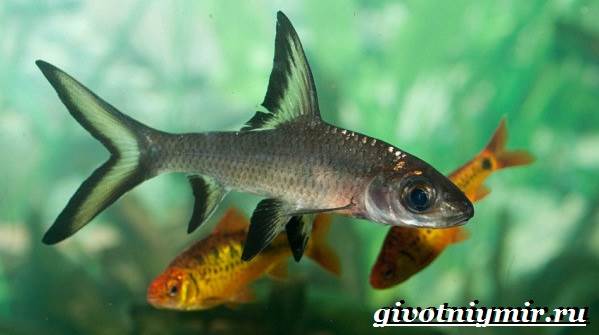
In order for the shark to feel normal and reproduce, it is necessary to monitor the cleanliness of the water in the aquarium; for this it is recommended to change 25% once a week.
Poor dimorphism appears only during spawning, during which time the female begins to exceed the male in size.
The fish is ready to reproduce when it reaches 10-15 centimeters in size. Even experienced breeders cannot accurately find signs of representatives of one sex or another before this.
In preparation for spawning, a separate special aquarium of at least 300 liters is equipped. temperature regime it should be 25-27 degrees Celsius.
The bottom is most often left clean, this makes it easier to maintain cleanliness and monitor the eggs. In order not to create additional danger for children, you need to install a filter with one washcloth and without a lid.
Immediately before spawning, a boy and a girl, who subsequently form a short-term pair, dance in the water.
The process itself consists of several steps: the female develops eggs throughout the water, then the male fertilizes them.
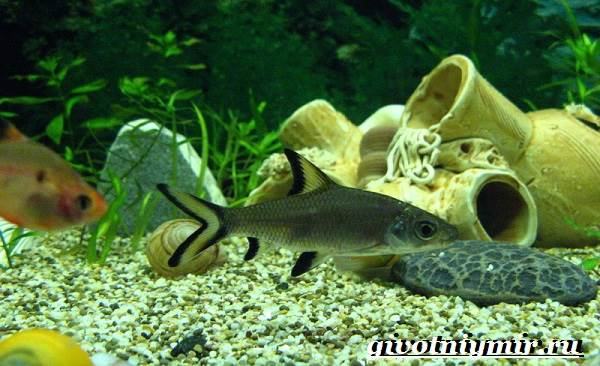
Breeders believe that in order to increase the number of fertilized eggs, it is necessary to organize a current in the aquarium.
As soon as this process is over, its culprits no longer pay any attention to the caviar, but the adult balus are still immediately put aside, since mating games on these gluttons make them even more hungry, that is, caviar can become their usual food.
It is recommended to have 2-3 boys for each girl. Before spawning, the water should be artificially softened.
Breeders have different opinions about the bottom of the aquarium. Some say that it is best to leave the bottom clean in order to observe the eggs and make it easier to clean the aquarium.

However, others claim that Java moss placed on the bottom will have a positive effect on the maturation of the fry. After spawning, 50% of the water is changed every day.
Buy a shark ball You can buy it in specialized pet stores or directly from the breeder. With quality care, a healthy individual can live up to ten years.
SHARK BALA
Bala shark is a very interesting silvery fish that looks like a miniature oceanic shark. Of course, they are not relatives, but there are similarities. It is also worth saying that the “Aquarium Shark” is a peaceful and harmless fish. Some people insultingly compare it with a roach, while others do not understand the charm of these fish at all, however, as they say, there are no comrades for the taste and color.
In our opinion, given the unpretentiousness of this fish, given its nimbleness and peculiar shark-like beauty, it can be recommended not only to beginners, but also to experienced aquarists.
|
|
Latin name: Balantiocheilus melanopterus Russian synonyms: bala shark, firetail barb, shark barb, balantiocheilus, silver shark, tricolor shark. Foreign titles: Bala shark, Silver shark, Tricolor shark. |
|
How long do they live: By aquarium standards, Baloo's life is quite long, with good conditions Contents live up to 10-12 years. You can find out how long other fish live Minimum aquarium volume: In principle, shark balus can be kept even in an aquarium of 100 liters or more, in such an aquarium you can plant 1, well, a maximum of two fish. However, as you know, the larger the aquarium, the better. Taking into account the fact that these fish are quite large - the fish can reach 35 cm in length, then minimum size The aquarium size for them should be from 300 liters, and preferably 500 liters. If sharks are kept in small aquarium, then they simply will not grow up, they will not feel comfortable and, as a result, they will live less. See how many fish you can keep in X liters of aquarium (at the bottom of the article there are links to aquariums of all sizes). The aquarium for Bala sharks should be wide. Care requirements and conditions for keeping shark balls: They do not require any special conditions of detention. In fact, maintaining optimal aquarium water parameters is the key to their well-being. However, it is worth remembering that: Aeration and filtration are required, as well as weekly changes of up to 1/4 of the volume of aquarium water. The aquarium must be covered with a lid, the fish are nimble and jumping. Sharks feel comfortable among living vegetation. However, you should not plant the aquarium densely; for sharks, five Vallisneria bushes are enough. Decoration of the aquarium, at your discretion: stones, grottoes, driftwood and other decorations. The aquarium must have an open space for swimming. Shelters are absolutely unnecessary.
Feeding and diet of sharks: They are unpretentious in food, omnivorous, prone to overeating. They happily eat live, dry food and substitutes. They especially love live and frozen food (brine shrimp, daphnia, etc.). Feeding bloodworms is not recommended. The fish take food from the middle layer of the aquarium water. Food is not readily taken from the bottom. Feeding any aquarium fish ok should be correct: balanced, varied. This fundamental rule is the key to the successful keeping of any fish, be it guppies or astronotuses. The article talks about this in detail, it outlines the basic principles of the diet and feeding regime for fish. In this article, we note the most important thing - feeding fish should not be monotonous; the diet should include both dry food and live food. In addition, you need to take into account the gastronomic preferences of a particular fish and, depending on this, include in its diet food either with the highest protein content or, conversely, with plant ingredients. Popular and popular food for fish, of course, is dry food. For example, you can find food from the Tetra company, the leader of the Russian market, on aquarium shelves all the time and everywhere; in fact, the range of food from this company is amazing. Tetra’s “gastronomic arsenal” includes individual food for a specific type of fish: goldfish, cichlids, loricariids, guppies, labyrinths, arowanas, discus, etc. Tetra has also developed specialized foods, for example, to enhance color, fortified, or for feeding fry. You can find out detailed information about all Tetra feeds on the company’s official website -
It should be noted that when purchasing any dry food, you should pay attention to the date of its manufacture and shelf life, try not to buy food in bulk, and also store the food in a closed state - this will help to avoid the development of pathogenic flora in it. In nature they live: Homeland - Thailand and the islands of Southeast Asia. Natural bodies of shark baloo are fast streams and rivers, which is why it is better to install a powerful aerator with a filter in your home aquarium, which will create appropriate water flows. Description: Fish have a narrow, laterally compressed body, large eyes and a lower mouth. There are no mustaches. The main body color is silver-steel. The scales are large, resembling a small mirror. The pectoral fins are colorless. The rest are either transparent or yellowish with a wide black border. Males are slimmer and smaller than females. I repeat, they can reach 35 cm in length. Schooling, nimble, jumping fish. It is better to keep a school of at least 5 fish. Shy. A little history: In 1851 they were first studied and described. Breeding and reproduction of shark baloo: Reproduction of shark baloo is very difficult: Firstly, you need an impressive aquarium for maintenance and spawning. Secondly, hormonal injections are needed. Sex differences are weakly expressed. It is not possible to distinguish the sex of young fish. Sex determination is possible only when the fish reaches a length of 14 cm. Males are larger and rounder. The bottom of the spawning aquarium is covered with a separate net, and the spawners are planted in a one to one ratio. The female lays up to 10,000 eggs. At the end of spawning, the spawners are removed. The incubation period of the eggs is two days, then the larvae appear. On the third day, the juveniles begin to swim in a school. Starter food: live dust. Under good housing conditions, juveniles grow quickly. Comments and additions from our fish breeding expert V. Chernyavsky Now - about reproduction... Firstly, the spawners must be more than 4 years old and their size must be at least 35-40 cm. Secondly, the size of the spawning tank must be very impressive - at least 2 meters in length , up to 60 cm deep, about 50 cm high. The total volume of water is 1200-1500 liters. Moreover, the water should be soft. For successful spawning, at least 20 kg of Java moss is placed on the bottom, on which the eggs will be deposited. To trigger spawning, it is necessary to change the water for some time to cooler and softer water - and then raise the temperature. For spawning, 2 males and 1 female are planted. At the end of spawning, the males and females are removed, and methylene blue or another antifungal drug is added to the water with the eggs. On the third day, the methylene must be removed using coal. Every day it is necessary to replace the water by 50% of the volume with water of the same composition and the same hardness. Shark Ball Disease Shark baloo are very resilient fish and can withstand harsh conditions. However, you should not experiment, such excellent health does not last forever. The key to successfully keeping fish is to provide them with a spacious aquarium and optimal conditions water. They are susceptible to all typical diseases of aquarium fish and there are no nuances in their treatment. Susceptible to aeromonosis. Fish are treated in the standard way: by raising the temperature to 30 degrees, methylene blue, trypaflavin, salt baths, etc. The following section of the site will help you in matters of treatment: AQUAMEDICINE.
|
Shark baloo, or bala, or, as it is also called, shark barb, is now not uncommon in Russian pet stores. It is in constant demand among aquarists. Although not bright and colorful, this representative of the carp family nevertheless attracts with its sparkling swiftness. Therefore, if you want to recharge yourself with energy and vitality, you just need to sit for half an hour in front of an aquarium with these fish. What conditions does the ball need to create for them to feel good? Let's figure it out now.
Baloo is an elongated, silvery fish with large shiny scales. Its fins are yellowish in color with a wide velvet-black border. The dorsal fin is high, which, along with its swiftness, gives this fish a resemblance to a shark.
One thing you should definitely keep in mind before purchasing a Bala is that it is a very large fish!
It’s just that in pet stores they usually sell juveniles 5-6 cm long, and inexperienced aquarists are happy to buy them for their small aquariums, not knowing that the fish grow up to 15-20 cm, and in small volumes they feel uncomfortable and get sick.
Behavior
 Baloo are schooling, non-aggressive fish. They are comfortable in the company of at least five individuals. Alone or in pairs, they behave restlessly, become timid or cocky, are more demanding of water quality and oxygen levels, and are more susceptible to disease.
Baloo are schooling, non-aggressive fish. They are comfortable in the company of at least five individuals. Alone or in pairs, they behave restlessly, become timid or cocky, are more demanding of water quality and oxygen levels, and are more susceptible to disease.
The overwhelming majority of these fish in our pet stores are caught in natural conditions; accordingly, they are poorly adapted (and sometimes not adapted at all) to being kept in captivity.
This manifests itself in extreme nervousness when, when cleaning the aquarium or simply turning on the light suddenly, the fish panic, try to escape without seeing the glass, and can become seriously injured and frighten other fish.
Therefore, during the first few weeks of keeping a Baloo, you need to be careful in caring for them, minimizing the amount of stress on them.
Shark Ball: contents
Baloo is considered an unpretentious, strong fish that usually does not cause problems for the aquarist. This is true if the following conditions are met during its content.
Firstly - and this is the most important thing! - the ball needs large aquarium. At least a meter long and quite wide (not in the form of a screen). The volume should be at least 200 liters, preferably 350-400 liters.
We must remember that an adult balu is a large, agile, fast fish, and, moreover, as we have already said, they are kept in schools of at least five individuals.
Secondly, since in nature the balu lives in clean, fast streams, an aquarium with them requires powerful filtration to create a strong current and a high oxygen content.
The remaining conditions are less important. Fish live in water with a pH close to neutral, in wide range hardness, at temperatures from 22°C to 28°C. Water changes should be done weekly, from a quarter to half the volume.
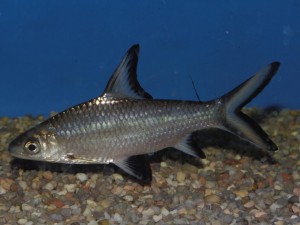 Balu is damaged by plants with delicate and soft leaves, so hard-leaved bushes are planted in a jar with them or without greenery at all, but in this case it is highly recommended to install a phytofilter that will purify the water from nitrogen and phosphorus and enrich it with oxygen.
Balu is damaged by plants with delicate and soft leaves, so hard-leaved bushes are planted in a jar with them or without greenery at all, but in this case it is highly recommended to install a phytofilter that will purify the water from nitrogen and phosphorus and enrich it with oxygen.
When decorating a pond for a ball, you should not overuse decorations, stones, snags, or create dense, tall thickets. This fish requires a lot of space for free, high-speed swimming, so all decorative elements should be located only around the perimeter, taking up a minimum of space. Shark barbs do not need shelter.
Feed
Like many other carp fish, baloo are omnivorous and voracious. They eat live and frozen food, as well as dry granules and flakes, and plant foods.
When feeding, two conditions must be observed:
- plant food should make up at least a tenth of the diet; you can use chopped lettuce, zucchini, spinach or ready-made dry food, for example, with spirulina;
- It is not recommended to feed balus with bloodworms, since they have weak stomachs that do not digest the hard chitinous coverings of these invertebrates well.
If you want to pamper your fish, you can use large daphnia for juveniles, and for adults, cut earthworms or balls of the worm Aulophorus, which are easy to grow at home.
It must be borne in mind that balus prefer to feed in the middle layers of water; they are reluctant to take food from the bottom, so the food should not sink quickly.
Reproduction
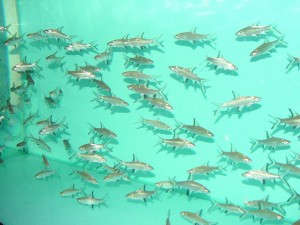 In captivity, shark barbs practically do not reproduce. You can get offspring only with the help of hormonal injections, similar to those used for reproduction, and if a number of conditions are met:
In captivity, shark barbs practically do not reproduce. You can get offspring only with the help of hormonal injections, similar to those used for reproduction, and if a number of conditions are met:
- manufacturers must be over 4 years old;
- their size must exceed 35 cm;
- The length of the spawning tank is at least 2 meters, the volume is more than a ton;
- at the bottom there is a litter of several kilograms of moss or small-leaved plants on which eggs will be deposited.
Since it is more expensive to create such conditions than to import fish, almost all commercially available fish are wild-caught in Southeast Asia. By the way, massive, predatory fishing has led to the almost complete disappearance of balu in some rivers.
Shark Ball: compatibility
If the Balu is kept according to the rules, in a large aquarium and in a flock, it can be called a problem-free neighbor.
The main thing is that the fish kept with it are not so small as to fit in its mouth, and do not have long veil fins that will definitely be plucked (after all, it is a barb!).
And, of course, you should not house the Bala with very aggressive cichlids. He can stand up for himself, but he will not survive in a state of constant terror.
That is, the ball can be kept together with
- large barbs (for example, bream),
- loach fish,
- (thoracatum, plectostomus, pterygoplichthus),
- calm cichlids,
- medium-sized unveiled viviparous.
In any case, fish get along better if they are acquired at a tender age and raised together.
As you can see, there is nothing complicated about the content of the ball. A spacious reservoir, good filtration, proper food - and you can be charged with the energy and swiftness of these small sharks for many years.
Freshwater fish of the carp family. Popular tropical fish. Another name is silver shark. The shark baloo is similar in appearance to the roach: a thin, long body, laterally compressed; big eyes. Large scales resemble many small silver-steel mirrors. The fins can be transparent, yellow or with a yellowish tint, the dorsal is sickle-shaped, the edging is black, wide. The back is slightly darker than the sides and belly. The dorsal fin resembles that of a shark. In the photo in front of us is a real giant shark. The mouth is located below, there is no mustache. A nimble, jumping, timid fish; loves to live in a flock of more than five individuals. Native to Thailand, Southeast Asia. Loves ponds with running water. The movements of the fish are graceful and smooth. Susceptible to stress (panics in case of sudden movements during water purification). It takes a month to get used to new conditions. Life expectancy is about 10 years. Hypersensitive to water pollution. Listed in the Red Book.
Keeping an aquarium fish Shark Balu
The shark's habitat is rivulets and streams with a fairly fast flow, therefore, for an appropriate flow of water into the aquarium, it is advisable to install a strong aerator with a filter. Water is preferably of medium hardness or soft, with acidity slightly below zero, water temperature 24-25 degrees. The fish loves currents and natural light. Sometimes the Shark Ball jumps out of the water, so the aquarium must be covered with a lid. IN natural environment grows up to 40 cm, in captivity it will grow less - up to 20 cm.
Omnivorous fish. Live, dry, plant food is suitable for food. Vegetables that are suitable include: nettle leaf, scalded lettuce, dandelion and spinach. Feeding should be varied and balanced. Bloodworms and cheese are not suitable for food - they can cause stomach upset. Dry food needs to be changed periodically. Such food must be purchased in packages in accordance with the date of manufacture. Store closed so that pathogenic flora does not develop in it. You also need fish food - in flakes, granules, frozen, freeze-dried, enriched with vitamins. The diet needs to be varied as much as possible.
Eats actively all day long. It takes food from the water column, but reluctantly from the bottom. While eating, they characteristically grab food with their gills and make gurgling sounds. A voracious fish can harm itself, so you need to regulate the amount of food and sometimes arrange a fasting fasting day.
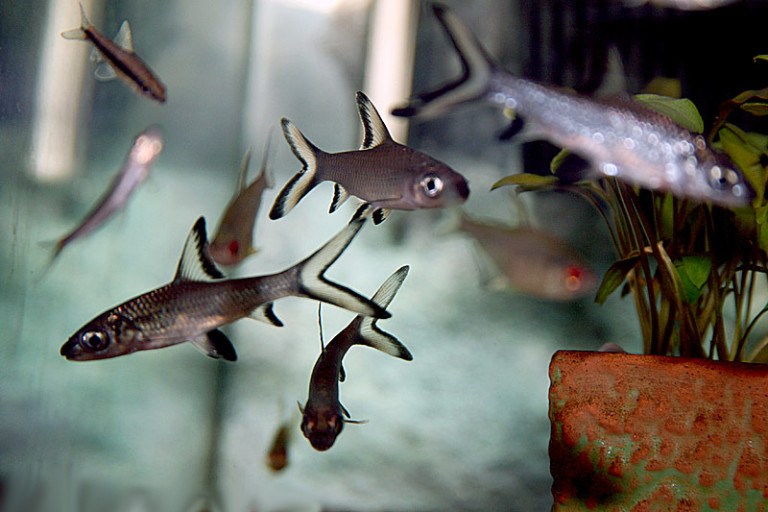 The aquarium should be decorated with pebbles, as well as small driftwood, since the fish prefers large spaces. It is allowed to add artificial or aquarium plants: Anubias, Vallisneria, add snails.
The aquarium should be decorated with pebbles, as well as small driftwood, since the fish prefers large spaces. It is allowed to add artificial or aquarium plants: Anubias, Vallisneria, add snails.
When purchasing a new inhabitant(s), you should not immediately add him/her to the rest of the fish in the aquarium. Create a quarantine. Monitor her health for a week or two. If the fish is healthy, you can release it into the main aquarium. You can also quarantine a sick fish and treat it separately from others without exposing it to medicines all inhabitants sea house. They may suffer from rubella, semolina, and aeromonosis.
Very often fish get sick due to poor water quality. Therefore, a weekly 30 percent water change is provided.
Do not frighten: knock, turn on bright lights, do not make sudden movements in the water.
Compatibility with other fish
A peaceful, friendly fish, it will get along with guppies in the same aquarium, although they do not like the inhabitants of another species and find it difficult to get used to them. Predatory fish are not desirable neighbors; they bully you and bite your fins. They get along well with large neighbors and with fish of the same size. As they grow, they eat smaller fish (neons) and fry.
Sexual differences between male and female
The female is larger than the male, the sex of young fish practically does not differ. Adult males are slimmer than females. In two years they can bear offspring.
Reproduction
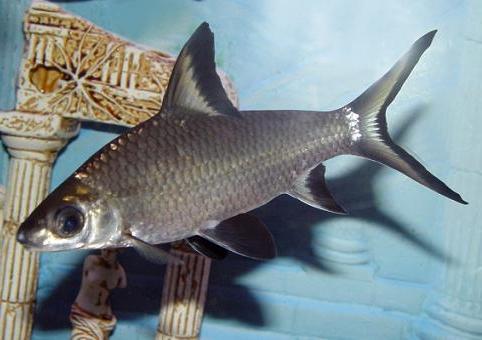 Breeding in captivity is difficult, but you can still try. For spawning, you can take a three-year-old fish: one female (35 cm in size) and several males (25 cm). Possibly in pairs. In the first case, more eggs are fertilized. To breed fish you need a large aquarium - up to two hundred, or preferably four hundred liters. To obtain offspring, you need to change the temperature and hardness of the water: first lower it, then increase it. The fish are also injected with hormones. Before spawning begins, mating dances can be observed.
Breeding in captivity is difficult, but you can still try. For spawning, you can take a three-year-old fish: one female (35 cm in size) and several males (25 cm). Possibly in pairs. In the first case, more eggs are fertilized. To breed fish you need a large aquarium - up to two hundred, or preferably four hundred liters. To obtain offspring, you need to change the temperature and hardness of the water: first lower it, then increase it. The fish are also injected with hormones. Before spawning begins, mating dances can be observed.
The bottom is covered with a separate mesh. The female lays more than 10 thousand eggs. On the third day, young fish emerge from the larvae. The fry's food is ciliates, rotifers, and live dust.
This is a rare breed of fish - a find for true connoisseurs. And may they find a worthy, caring owner in you!
| Basic information | |
|---|---|
| Name | Shark Ball |
| Scientific name | Balantiocheilos melanopterus |
| Origin | Asia |
| Maximum size | 250-350mm |
| Minimum aquarium size | 180l |
| Temperature: 24-27 °C pH: 6.5-7.5 |
|
| Omnivore | |
| Behavior and Compatibility | |


